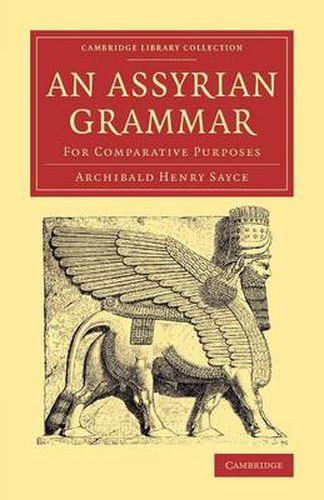Readings Newsletter
Become a Readings Member to make your shopping experience even easier.
Sign in or sign up for free!
You’re not far away from qualifying for FREE standard shipping within Australia
You’ve qualified for FREE standard shipping within Australia
The cart is loading…






Archibald Henry Sayce (1845-1933) became interested in Middle Eastern languages and scripts while still a teenager. Old Persian and Akkadian cuneiform had recently been deciphered, and at the same time Indo-European studies had emerged as a lively field, with publications by scholars including Grimm, Bopp and Schleicher. Assyrian offered opportunities to historians of the Semitic languages similar to those provided by Avestan to Indo-Europeanists, and Sayce’s grammar, published in 1872, was aimed at such an audience. Only transliteration was used, as cuneiform would be both expensive and redundant for philological purposes. In his preface, Sayce acknowledges the recent work of Oppert, Hincks, and Smith (whose translation of part of the epic tale of Gilgamesh attracted considerable publicity later that year). Sayce considers the place of Assyrian in the Semitic language family and its development over time, and reviews the archaeological evidence and scholarly literature, before presenting its phonology, morphology, syntax and prosody.
$9.00 standard shipping within Australia
FREE standard shipping within Australia for orders over $100.00
Express & International shipping calculated at checkout
Archibald Henry Sayce (1845-1933) became interested in Middle Eastern languages and scripts while still a teenager. Old Persian and Akkadian cuneiform had recently been deciphered, and at the same time Indo-European studies had emerged as a lively field, with publications by scholars including Grimm, Bopp and Schleicher. Assyrian offered opportunities to historians of the Semitic languages similar to those provided by Avestan to Indo-Europeanists, and Sayce’s grammar, published in 1872, was aimed at such an audience. Only transliteration was used, as cuneiform would be both expensive and redundant for philological purposes. In his preface, Sayce acknowledges the recent work of Oppert, Hincks, and Smith (whose translation of part of the epic tale of Gilgamesh attracted considerable publicity later that year). Sayce considers the place of Assyrian in the Semitic language family and its development over time, and reviews the archaeological evidence and scholarly literature, before presenting its phonology, morphology, syntax and prosody.